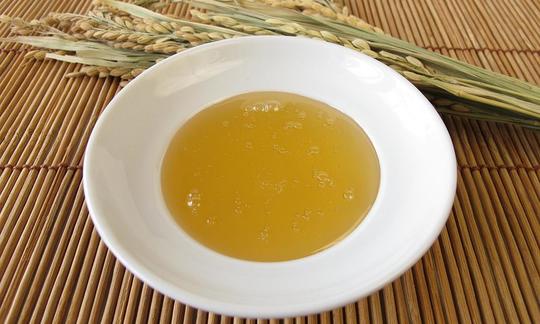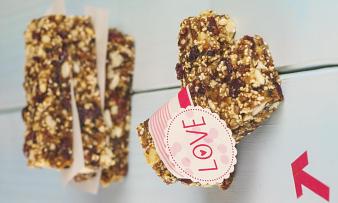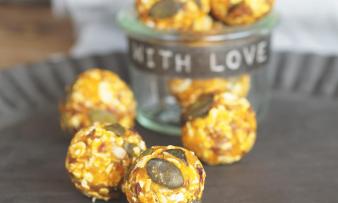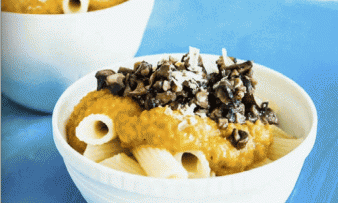Table of contents
What is rice syrup? Rice syrup ( organic?) or brown rice syrup usually refers to a syrup made from whole grain rice (brown rice) by fermentation. Rice syrup is never raw, as it is mostly made from rice flour heated in water (traditionally from cooked rice grains).
Using rice syrup in the kitchen:
Rice syrup is vegan and can be used as an alternative sweetener for many different dishes and foods (not suitable for raw food). In vegan cuisine, brown rice syrup is a popular honey substitute because it is similar to honey in consistency and appearance. Rice syrup is suitable for sweetening and refining muesli, desserts, ice cream, as a spread and for baking. The mild-tasting rice syrup can also be used to round off hearty vegetable dishes or rice dishes. Salad dressings and dips are given a mild sweetness by adding vegan rice syrup. Rice syrup is also used as a sweetener for some drinks, e.g. rice milk (vegan).
The rice syrup flavor has a low to mild flavor with a slightly nutty caramel note. The sweetness of rice syrup is less than that of granulated sugar, so a larger amount of rice syrup is needed to achieve the same intensity. About a cup of rice syrup (or malt sugar) can be substituted for ¾ cup of honey, maple syrup or granulated sugar. 1
If you want to replace the granulated sugar in one of your recipes with rice syrup, you should reduce the amount of remaining liquid by about 10%. This way, the cake or pastry will turn out well.
Vegan rice syrup recipe for raspberry ice cream on a stick:
Ingredients (for 5 people): 200 graspberries, 125 ml unsweetened plant milk (e.g. almond milk, soy milk, rice milk), 1 banana, 1 tbsp rice syrup (organic).
Preparation: Peel the banana, wash the raspberries, put them in a bowl with rice syrup and plant milk and puree finely with a mixer or hand blender. Fill the raspberry mixture into ice cream molds and insert a wooden stick as a stick. The vegan raspberry ice cream must now harden in the freezer for at least 4 hours or, ideally, overnight, then it is ready to eat.
Vegan recipe for carrot muffins with rice syrup:
Ingredients (for 6 people): 100 g rice flour, 80 ml water, 50 g grated carrots, 50 g rice syrup (organic), 50 g ground walnuts, 30 ml rapeseed oil, 2 tsp baking powder, pulp of a vanilla pod.
Preparation: Preheat the oven to 180 °C fan. Mix together the rice flour, nuts, grated carrots and baking powder. Add the rapeseed oil, rice syrup, water and vanilla pulp and stir in. Divide the mixture into 6 muffin cases and bake the muffins in the oven for 20-25 minutes until golden brown. Enjoy the vegan muffins once they have cooled down.
Vegan recipe for ginger tea with mandarins and rice syrup:
Ingredients (for 2 people): ½ l water, approx. 15 g fresh ginger, juice of 2 mandarins, 1-2 tsp brown rice syrup (organic).
Preparation: Cut the peeled ginger into thin slices, boil it in ½ l of water and then let the tea steep for about 20 minutes at a low temperature. Use a citrus press to squeeze the two mandarins and add them to the tea with the rice syrup. Filter the tea through a fine sieve before serving.
Vegan rice syrup recipes can be found under the note: " Recipes that have the most of this ingredient ".
| Not only vegans or vegetarians should read this: Vegans often eat unhealthily. Avoidable nutritional errors. |
Shopping - where to buy rice syrup?
Rice syrup is available in many western Asian shops under the English name maltose syrup (rarely: maltose syrup); the name maltose syrup is derived from the high content of maltose, i.e. malt sugar. Fair trade and GMO-free rice syrup in organic quality (organic) can be found in health food stores, organic shops, organic supermarkets (e.g. Denn's Biomarkt, Alnatura), drugstores or specialty stores. Various Internet providers also have organic rice syrup (vegan) on their websites.
Due to its growing popularity in Europe, rice syrup and organic rice syrup can now also be found in some well-stocked supermarkets, such as Edeka, Migros, Rewe, Coop and Spar. Other major retailers such as Aldi, Hofer and Lidl occasionally offer rice syrup as special offers. Stores such as Denner and Volg usually do not sell rice syrup in their stores.
There are two different types of rice syrup on the market: the industrially produced rice syrup made from rice flour and the traditionally produced malt syrup made from whole grain rice with a small amount of germinated barley grains (barley malt). The latter product is also often referred to as rice malt or risomalt. For details, see "Possible confusion".
Storage of rice syrup - shelf life:
Rice syrup has a shelf life of about one year. After opening, rice syrup should be stored in a cool, dry place, preferably in the refrigerator. If stored in the refrigerator for a long time, syrup can reach a viscous consistency; if you put it in warm water for a short time, it will be more liquid again. If you have bought large quantities of rice syrup, you can freeze it in portions and thaw it when you need it.
Rice syrup ingredients - nutritional values - calories:
100 g of brown rice syrup contains 308 kcal. These mainly come from carbohydrates (77 g/100g), of which 54 g are sugar. Industrially produced brown rice syrup is low in nutrients: it is fat-free and has hardly any proteins and fiber (hemicellulose). This rice syrup consists of about 38% maltose, 16% glucose and usually contains practically 0% fructose (fructose). 5,18
Rice syrup contains 0.1 mg/100g of copper. Sour cherries and Boscs bottle pears have a similar content.Black pepper (205.3 mg/100g) and port wine (10 mg/100g) contain particularly high levels of copper. 2 Copper is an essential trace element that is involved in the endogenous antioxidant system and in the formation of connective tissue, pigments and hemoglobin. 3 However, we almost never suffer from a deficiency.
Rice syrup contains 194 mg of potassium per 100 g, which is 10% of the daily requirement. Tofu contains a comparable amount of potassium. Spices such as turmeric (2080 mg/100g) and chili flakes (1870 mg/100g) have significantly higher values. 2 Potassium is important for the regulation of the membrane potential of the body's cells. 4
Iron is present in rice syrup at 1.2 mg/100g, which makes up 9% of the daily requirement. Sweet soy sauce and umeboshi paste have similar iron contents at 1.4 mg/100g. Some dried herbs, such as thyme (124 mg/100g) and basil (90 mg/100g), are particularly high in iron.
The complete ingredients of rice syrup (nutritional values), the coverage of the daily requirement and comparison values with other ingredients can be found in our nutrient tables. In the article Nutrients explained you will get a detailed insight into the topic.
Health aspects:
Is rice syrup unhealthy? or Is rice syrup healthy? Brown rice syrup is a vegan and mostly well-tolerated alternative to honey. However, industrially produced rice syrup contains only a few nutrients (keyword: empty calories), whereas traditionally produced syrup used to be richer in nutrients. Many products touted as "healthy" such as breakfast cereals, cereal bars and energy drinks as well as baby food contain this sweetener. To achieve the same sweetness, you need significantly more rice syrup than, for example, granulated sugar, as its sweetening power is higher.
Dangers - Intolerances - Side effects:
Brown rice syrup has a glycemic index (GI) of 98. In comparison, table sugar has a significantly lower GI (65). 6 Rice syrup should therefore only be consumed in moderation. Glucose, with a GI of 100, forms the basis for measuring the glycemic index.
Is rice syrup gluten-free? Rice syrup can be gluten-free if it is produced without the addition of grains containing gluten or if the protein fractions are removed through the clarification process.
Brown rice syrup contains little to no fructose and can therefore be tolerated by people with hereditary and intestinal fructose intolerance (fructose malabsorption). 15,18 In non-industrial rice syrup, the addition of germinated barley results in a slightly higher fructose content. A comparison of various non-industrial rice syrup types in European databases has shown us that these contain very low levels of fructose (usually less than 200 mg in 100 g of syrup). However, they are certainly still much healthier than the finished industrial product.
Does rice syrup contain arsenic? According to a 2012 study, brown rice syrup and products containing the syrup contained significant amounts of inorganic arsenic (As), which is toxic and carcinogenic to humans. This is probably due to the high prevalence of arsenic in rice. 7 The use of pesticides and fertilizers in rice cultivation causes the heavy metal arsenic to accumulate in the soil. The rice plant absorbs the arsenic through its roots and accumulates it in its seeds and leaves. Small children absorb arsenic even more easily than adults, which is why children under 3 years of age should not be given rice products too often. 8
FODMAPs, which include fermentable oligosaccharides, disaccharides, monosaccharides and polyols, are food ingredients, each of which is known to be a potential cause of intolerance due to poor absorption in the small intestine. Since brown rice syrup contains oligosaccharides (complex sugars), people who are sensitive to oligosaccharides should avoid consuming rice syrup. Consumption of rice syrup can otherwise lead to bloating, abdominal pain and diarrhea. 9
Occurrence - origin - ecology:
Rice syrup, which comes from Asia (probably Japan 19), is one of the oldest sweeteners in the world and requires rice for its production. Today, around 90% of the rice harvest takes place in Asian countries such as China, India, Japan and Thailand. But rice is also grown in the USA and Europe (Italy, France, Spain, Portugal). 10, 11
Ecological aspects:
The ecological balance of rice syrup made from brown rice is rather poor. The frequent use of pesticides and fertilizers in rice-growing areas leads to soil and groundwater contamination. In addition, wet rice cultivation requires a lot of water and releases around 100 million tons of climate-damaging methane every year. Dry rice cultivation is more climate- and environmentally friendly. 13,14
The long transport routes of rice and rice products (such as rice syrup) lead to the emission of greenhouse gases and air pollution. It is therefore advisable not to consume rice syrup in excess and always to use organic rice syrup.
Possible confusion:
Rice syrup is considered "malt syrup", even if modern manufacturing methods no longer require the addition of barley malt. However, in everyday use, the term malt syrup is almost exclusively reserved for barley malt syrup (see ingredient malt syrup). Both of the sweeteners mentioned get their sweet taste through fermentation processes with the help of enzymes.
Depending on whether the rice syrup is made using the traditional method (with germinated barley) or industrially, the result will be darker or lighter. The first variant is also called rice malt 18 (rice malt syrup), is much browner and has a maltier caramel flavor. However, the rice malt also contains gluten and is not suitable for people with gluten intolerance. 15
Although malt actually refers to malted grain, the terms malt and malt syrup can be used interchangeably in everyday life.
Rice syrup production:
Traditional: In traditional rice syrup production, small amounts of germinated barley (barley malt) are added to cooked whole grain rice. The enzymes in the barley malt convert the carbohydrates, proteins and lipids into a sweet solution. After the solid components have been filtered out of the solution, the rice syrup is boiled down to obtain a lower water content and a concentrated, syrupy, thick consistency. After fermentation, the syrup contains less glucose (simple sugar) but a lot of maltose (double sugar). 16
Industrial: In the industrial production of rice syrup, the wholegrain rice is first ground into rice flour. The rice flour is heated with water and the enzymes are allowed to work. The enzymes used here do not come from the germinated barley, but from fungi or bacteria that come from organic bioreactors. Production does not require synthetic chemicals and is similar to traditional rice syrup production. The use of enzymes that are produced using genetically modified fungi or bacteria is possible in the case of auxiliary materials without the need to declare them (genetic engineering). The food industry now uses around 80% of such enzymes. For labels such as "without genetic engineering", "GMO-free" etc. or "organic", neither additives nor enzymes may be produced using genetic engineering. 12
Note: Can you make rice syrup yourself? Making your own rice syrup is difficult and is not recommended.
General information:
Rice syrup is a popular sugar substitute and is considered an alternative sweetener. Other plant-based sweeteners that are often used as sugar alternatives in vegan cuisine are maple syrup, agave syrup, stevia, date syrup or erythritol.
Alternative names of rice syrup:
Rice syrup (incorrectly spelled rice syrup, rice syrup, rice syrup, rice syrup) is also known as brown rice syrup (brown rice syrup), rice honey and rice sweetness (rice sweetness).
In English, rice syrup is known as rice syrup, rice malt syrup, brown rice syrup or brown rice malt syrup. Due to the high maltose content, some products also have names such as high-maltose syrup or maltose or maltose syrup. However, the focus is usually on thick syrups (from starch saccharification) with a very high maltose content, which are mainly used in the food and pharmaceutical industries. 17,18 Nevertheless, the term has spilled over into German, where maltose syrup is also rarely used to describe rice syrup. In Spain, rice syrup is called sirope de arroz.
Keywords for use:
Rice syrup (organic) can be used in cosmetic products, such as vegan face masks, that moisturize and soothe the facial skin.
Literature - Sources:
Bibliography - 19 Sources (Link to the evidence)
| 1. | Thespruceeats.com. What is brown rice syrup? |
| 2. | USDA United States Department of Agriculture. |
| 3. | Org TK, Klevay LM, Gay RE, et al. Alteration of the connective tissue network of striated muscle in copper deficient rats. J Mol Cell Cardiol. 1985; 17(12): 1173–83. |
| 4. | McDonough AA, Youn JH. Potassium homeostasis: the knowns, the unknowns, and the health benefits. Physiology (Bethesda). 2017; 32(2): 100–11. |
| 5. | Nutritional-software.at ÖNWT Reissirup Alnatura. |
| 6. | Glycemicindex.com. The University of Sydney. Glycemic Index Research and GI News. Rice Syrup. |
| 7. | Jackson BP, Taylor VF, Karagas MR, Punshon T, Cottingham KL. Arsenic, organic foods, and brown rice syrup. Environ Health Perspect. 2012; 120(5): 623–6. |
| 8. | Bayerisches Landesamt für Gesundheit und Lebensmittelsicherheit. Untersuchung von anorganischem Arsen in Kindernahrung - Untersuchungsergebnisse 2010 und 2011. 2012. |
| 9. | Smollich M, Vogelreuter A. Nahrungsmittelunverträglichkeiten Lactose-Fructose-Histamin-Gluten. Wissenschaftliche Verlagsgesellschaft: Stuttgart; 2018. |
| 10. | Brücher H. Tropische Nutzpflanzen. Ursprung, Evolution und Domestikation. Springer Verlag: Berlin; 1977. |
| 11. | Pflanzenforschung.de Pflanzensteckbrief Reis. |
| 12. | Ugb.de UGB Gesundheitsberatung. Heblik D. Enzyme: Heimliche Helfer aus dem Genlabor. UGB-Forum 1/2009. |
| 13. | Pini U. Das Bio-Food Handbuch. Ullmann Verlag: Potsdam; 2014: 609-611. |
| 14. | Pflanzenforschung.de Weltnahrungspflanze Reis. |
| 15. | Fructosefrei.de Reissirup: Süssungsmittel bei Fructoseintoleranz. |
| 16. | Oekolandbau.de Süsskraft durch Stärke. 2020. |
| 17. | Lin Q, Xiao H, Liu GQ et al. Production of Maltose Syrup by Enzymatic Conversion of Rice Starch. Food and Bioprocess Technology, 2011; 6(1), 242–248. |
| 18. | Stern.de Broschüre (aid infodienst). Zucker, Sirupe, Honig, Zuckeraustauschstoffe und Süssstoffe. |
| 19. | Japonte.net An artisan kome-ame (rice syrup) is more than a sweetener. |











Comments